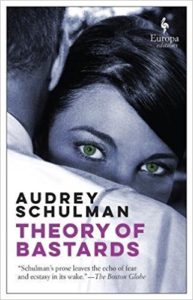Scientist and MacArthur Award Fellow Francine (Frankie) arrives in the near future at a facility dedicated to the study and protection of the non-human Hominidae, the great apes. Wooed there by the Foundation that runs the facility, Frankie is eager to use its resources and her ‘Genius Grant’ to study a group of bonobos as a means of testing and extending her theories on reproduction, and their influence on the mechanisms of biological evolution. Frankie begins this new chapter in her life while facing familiar personal challenges and physical complications arising from life-long endometriosis. Her intense focus on her work and the benefits provided her through the latest technology of ‘bodyware’ augmentations help Frankie persist through any disability caused by her condition. Meanwhile, another researcher there named Stotts facilitates her education on, and introduction to, the bonobos. The gentle, reserved Stotts focuses his research on the development of tool use in primates, but he looks to the relatively simple tools of communication utilized by the bonobos with a romanticized envy when compared to human technology.
Frankie’s progress with her bonobo subjects and her developing professional relationship and personal friendship with Stotts comes to a sudden halt when a giant dust storm sweeps out of the dry, abandoned corners of America to threaten the facility and its residents. Refusing to heed a mandatory human evacuation of the affected area, Frankie insists upon staying behind with Stotts to continue her research and help him care for the bonobos through the storm’s passing. However, the storm takes out their bodyware implants, all connections to communication systems, and compromises the bonobo’s habitat. As resources dwindle in the days following and people fail to return with help it becomes clear that the storm and damaged technology is a mere part to a catastrophe far larger.

Some descriptions for Theory of Bastards go out of their way to distance the novel from the science fiction genre or dystopian classification. Some infuriatingly assert that it can’t be considered science fiction because it is literary. Not only wrong, this statement is also unfortunate because it might turn many readers off who would otherwise really like the novel. Even more, genre fans are unlikely to even know of its existence due to limiting classification. Where many recent ‘literary’ novels utilizing dystopic elements have paled in comparison to works from genre that tackle similar plot and characters, Schulman’s novel actually succeeds tremendously across realms of conventional and speculative fiction. Apocalyptic in the literal sense, Theory of Bastards adds something special to a very crowded field by presenting compelling characters and superior prose tied into a plot that draws on biological science and technological speculations.
The first half of the novel establishes the near-future setting in subtle ways that organically fit into the whole. Likewise, Schulman uses these chapters to build her characters in their individual histories and their developing relationships. Frankie may serve as protagonist, but the other characters are just as richly formed, both human and bonobo. Readers become introduced to the major bonobo characters as Frankie herself gets to know them, observing their personalities. These bonobos become as relatable to the reader as Frankie or Stotts. The relatively slow foundation of setting and character in the first half of Theory of Bastards becomes extremely important as the dust storm arrives near the novel’s midpoint, ushering in increased flow to the plot that quickly builds to a dystopic crescendo that draws the novel’s themes of biology and technology together.
The benefits versus the risks of using technology to replace or enhance biology represents one of the obvious major themes in Theory of Bastards. Stotts’ work focuses on studying bonobo tool use and the potential to teach them increased tool use, ironically when he personally shuns overuse of technology. Frankie views Stotts’ work as a pipe dream, considering bonobo tool use to be physically limited by their biology, despite technology being used to overcome her own biological limitations. The arrival of the dust storm also represents a dose of irony when the effects of its choking clouds actually illuminate, unveiling the true nature of humans and the similarities we still share with our closest relatives.
Less clear in terms of the novel’s themes is the meaning behind the title. “Theory of Bastards” refers to an observation that Frankie makes in her research that hominids have an unconscious attraction to mate with an individual other than their normal partner when in heat. This concept is based on real research that Schulman references in an appendix following the novel. In reality it would be more properly still be a hypothesis, or perhaps a model. But ‘theory’ works much better as a novel’s title. With the relatively free sexuality of bonobo behavior, Frankie hopes to catalog their mating preferences, if any. She also hopes to develop an explanation based on evolutionary selection that would account for this observation of a biological drive to have bastards. Plenty of explanations do exist, but Schulman doesn’t really get into these. At most, she seems to illustrate the behavior in the relationship between Frankie and Stotts. Mutual attraction between the two is clear, but the married Stotts is not one to act upon that, even after civilization seemingly collapses and his family is out of contact half a world away. The ability of human consciousness and ethics to overcome natural ‘animalistic’ urges is clearly a focus here, but Schulman doesn’t seem to develop much more to say about it. Any connections she may be making between the theme of sexuality and the theme of technology/biology are murky.
Although some may find the first half of Theory of Bastards to be slow and a bit bloated, I found it captivating throughout. Even if not perfect, it is a superb example of fiction being used to develop conversation between the scientific concepts of biology and their social implications and limits for humanity and our evolutionary brethren.







